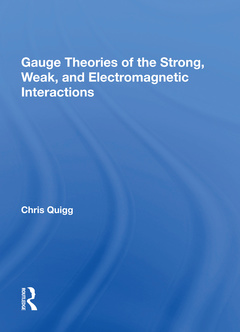Gauge Theories Of Strong, Weak, And Electromagnetic Interactions
Auteur : Quigg Chris

Date de parution : 06-2023
16.5x22.8 cm
Date de parution : 11-2021
16.5x22.8 cm
Thèmes de Gauge Theories Of Strong, Weak, And Electromagnetic... :
Mots-clés :
Gauge Bosons; Local Gauge Invariance; Baryon Number; Feynman Rules; Gauge Theory; CP Violation; Intermediate Bosons; Field Strength Tensor; Massless Gauge Bosons; Weak Isospin Doublet; Electron Positron Annihilation; Spontaneous Symmetry Breaking; Gauge Group; Intermediate Vector Bosons; Electromagnetic Interactions; Gauge Invariance; Yang Mills Theory; Parton Model; Goldstone Bosons; Euler Lagrange Equations; Gauge Fields; Local Gauge Transformations; Lagrangian Density; Neutral Current Interaction; Nucleon Decay



